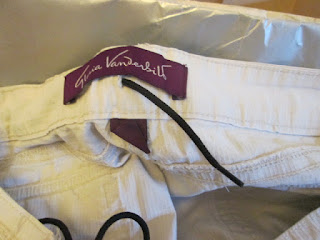Our years as cable TV customers—all two of them—have come to an end. As of last month, we have officially joined the growing ranks of
cord cutters who rely on other sources for our video goodies.
What's a bit ironic about this is that we never actually wanted to hook up that cord in the first place. As I wrote
back in 2013, the only reason we ended up subscribed to a cable service is that we needed to drop our no-longer-reliable landline phone from Verizon, and we discovered that Cablevision would give us a better deal for a package that included TV, phone, and Internet service than it would for phone and Internet only. In fact, after a few
tweaks to the original package deal, we ended up spending less for all three services than we used to pay for our Cablevision internet and Verizon landline separately.
Our original plan was to keep this "triple play" plan for one year until the promotion expired, and then drop the TV service. However,
when the time came, Cablevision offered to roll us over into a different promotion that would cost $95 a month—still marginally less than it would cost to pay for phone and Internet service separately. It was more than we'd have paid by going back to Verizon—about $44 a month more, in fact—but we decided it was worth it for reliable service.
So, based on this experience, we assumed that when our second triple play promotion expired, Cablevision would come back to us with yet another deal to convince us to keep it. Well, as it turns out, not so much. Last July we received a letter informing us that our rate for all three services was about to jump to $130: $50 for the TV, $45 for Internet, and $35 for phone.
So, I contacted Cablevision via chat and asked to cancel the TV service, thereby triggering a series of Evasive Maneuvers:
- First they told me the TV service had already been canceled. When I pointed out that we'd just gotten a letter saying we were going to be billed $50 for it, they said, "Oh, sorry, wrong account."
- Then they told me that since the account was in Brian's name, he has to call them himself to cancel it. It's true that his name is on the bills, but they're sent to my e-mail address, and we are both registered users of the account...but no matter. If the account's in his name, he has to cancel it himself.
- So Brian called them up and asked to cancel the TV service. The rep countered by offering to throw in Showtime for free, "a $20 value." How this was supposed to make it a good deal for us to keep paying $50 a month for something we didn't want, I'm not sure...but Brian made the mistake of pausing to consider it, and then when he said, "No thanks, please cancel the service," she refused to let it go. She wanted to know why he wasn't taking such an obviously great deal. What was he saying? Didn't we want free Showtime? Why not? What kind of idiots would pass up an offer like that?
- After several attempts to deflect her questions with, "We're just not interested" and "We'd really rather cancel," Brian finally lost his cool and snapped, "Would you PLEASE just let me cancel the service?!?" at which point the rep said, "Well, there's no need to yell"—but she did what he asked. Which seems to imply that there actually was a need to yell, since it's the only thing that got her to cooperate.
- When Brian went to return the cable box to Cablevision, he asked the clerk there a question he forgot to ask over the phone: was there some way to have the account transferred to be in my name, so that in future, I could make any necessary changes to it? The clerk responded that the account was already in both of our names and there should be no reason I couldn't make changes to it...thereby confirming that Evasive Manuever #2 was an outright lie.
So at this point, we have succeeded in dropping the TV service. That means we should be paying just $80 a month: $45 for internet and $35 for phone, right? No, hardly. By dropping the TV service, we've still lost our bundling discount, so the price for Internet has jumped from $45 a month to $60. So with taxes, our total bill for the two services is $99.14. That's less than the $125 we'd have paid if we'd kept the TV service, but it's more than we were paying last year for all three services—and more than the $80 a month Verizon is now offering for its cheapest
triple play deal.
This isn't the end of the story, however. Not long after this, a Verizon rep showed up at our door, explaining how they've just wired our whole neighborhood for FiOS. She even went so far as to point to the new wire that carries the signal ("that black one right there") to prove that they really, really do have high-speed service in our area now—unlike the last time we tried to sign up for it, when they strung us along for a month promising that our new DSL connection would be hooked up "in a couple of days" and then abruptly announced that no, they actually didn't have service in our area and cut off the dial-up connection they'd been letting us use up until that point, leaving us with no service at all. This experience led Brian to remark, "I'll listen to Verizon the day I see them stringing new cable on our street"—and now here was the rep actually pointing to the new cable.
I explained to the rep why we were reluctant to trust Verizon's promises, having been burned twice before, once on the DSL and once on the landline. She assured me that Verizon had been "working to upgrade its customer service" as well, but said she understood if the company just "left a bad taste in your mouth"—thereby implying that our anti-Verizon stance wasn't rational, but hey, that's okay, sometimes people just make decisions for irrational reasons. So she went away peacefully, but the encounter stuck in my mind...especially when I discovered, in the following weeks, that our Cablevision connection seemed to be growing less and less reliable. Both our telephone and our Internet connection started cutting out at unpredictable times, usually for just a few minutes, but sometimes for more like a few hours. This got me wondering: what's the point in paying more for a reliable connection if it's not, in fact, reliable? Could Verizon actually be, at this point, the lesser of two evils?
While I was still mentally debating this point, a
news story broke on Friday announcing that Cablevision had just been sold to a Dutch company called Altice. The CEO, Patrick Drahi (a name that doesn't sound at all Dutch, and isn't), announces that he's hoping to cut management salaries and outsource parts of the business to contractors, such as the "truck rolls," the folks who actually come out to your house and hook up your cable or fix it when it breaks. In the long run, he says, he hopes to start selling Internet, TV, and phone service a la carte, rather than as the bundles Cablevision currently offers.
To my mind, this can only be good news. It's not as if Cablevision's service could be much worse than it is now, and given that Europeans in general get
much better and cheaper Internet service than we do, having a European company in charge is probably a step in the right direction. If nothing else, it means that next time we call Cablevision trying to drop a service (perhaps the landline, if we decide to switch to
Ooma), we won't have to spend half an hour arguing with a rep desperate to keep us hooked up to a bundled service.
Unfortunately, this deal won't take effect until 2016, so we have no real hope of getting better or cheaper service from Cablevision until then. Which leaves the main question still unsolved: would we, in fact, be better off switching back to Verizon? Yes, they have screwed us over repeatedly in the past. But does that mean that Cablevision, as the only available alternative, automatically gets a free pass for screwing us over in the present?
 And somehow, out of this makeshift mismatch, came a hearty, flavorful soup, with savory mushrooms basking in a rich brown broth. Some of the credit for the soup's flavor is no doubt due to our favorite vegetable soup base from Penzey's Spices, which kicks the taste knob on any vegetarian soup up at least a notch or two. But some of it is certainly also due to Brian's recent discovery that mushroom soup in general tastes much better if you don't sauté the mushrooms first, as many recipes suggest you do. Throw them in the pot in their natural state, and all their juices will end up in the soup itself, rather than trickling round the edges of the saucepan.
And somehow, out of this makeshift mismatch, came a hearty, flavorful soup, with savory mushrooms basking in a rich brown broth. Some of the credit for the soup's flavor is no doubt due to our favorite vegetable soup base from Penzey's Spices, which kicks the taste knob on any vegetarian soup up at least a notch or two. But some of it is certainly also due to Brian's recent discovery that mushroom soup in general tastes much better if you don't sauté the mushrooms first, as many recipes suggest you do. Throw them in the pot in their natural state, and all their juices will end up in the soup itself, rather than trickling round the edges of the saucepan.



















